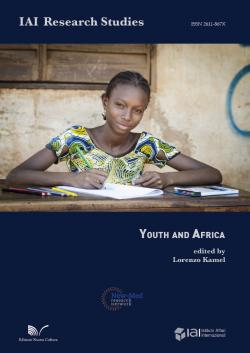Youth and Africa
According to UN projections, Africa’s population is set to double to 2.4 billion by 2050, and it is expected to hit 4.3 billion by the end of the century. By then, about one-third of all of humanity will live on the continent. While many studies have focused on the present and the future of Africa and its interconnections with Europe, it is rare to hear how young people from Africa view and interpret current developments unfolding in their countries. To fill this gap, Youth and Africa brings together seven outstanding young professionals from the Maghreb and sub-Saharan Africa. They shed light on challenges and opportunities, and remind us that “Africa is a voice to be heard, not a problem to be solved”.
Revised version of papers presented at the New-Med conference entitled “Youth and Africa: Exploring New Approaches to Economic Cooperation, Security and Migration”, held in Rome on 5 March 2020 and organized by the Istituto Affari Internazionali (IAI) and the OSCE Secretariat in Vienna, in cooperation with the Italian Ministry of Foreign Affairs and International Cooperation, Fondazione Compagnia di San Paolo and German Marshall Fund of the United States.
-
Details
Rome, Nuova Cultura, 2020, 119 p. : ill. -
Issue
3 -
ISBN/ISSN/DOI:
978-88-3365-307-5
List of Contributors, p. 9-10
List of Abbreviations, p. 11-13
Introduction, by Lorenzo Kamel, p. 15-18
1. Regional Migration Regimes and Border Security in the Horn of Africa, by Margaret Monyani, p. 19-32
1.1 Historical background of IGAD
1.2. Migration drivers and trends in the Horn of Africa
1.3. IGAD’s migration regime structure
Conclusion
References
2. The Women of Sudan in Times of War and Peace, by Aya Damir, p. 33-48
2.1 A brief history of Sudanese women’s political engagement
2.1.1 Women in peace negotiations
2.2 The role of women in overthrowing al-Bashir
2.2.1 Juba Peace Negotiations (JPN)
2.2.2 Gender analysis of the Constitutional Declaration
2.3 Conclusion and policy recommendations
2.3.1 The identity of Sudanese women
2.3.2 Policy recommendations
References
3. (Vulner)abilities of Sub-Saharan Women Migrants in Morocco, by Nabil Ferdaoussi, p. 49-63
3.1 Vulnerability reconsidered in the context of Sub-Saharan female migration in Morocco
3.2 Sub-Saharan female migrants: Deconstructing (vulner)ability
3.3 Morocco’s new migration policy fails: Instrumentalising human-trafficking discourse
3.4 Disproportionately vulnerable: Female Sub-Saharan migrants amid the outbreak of the COVID-19 pandemic
Conclusion and policy recommendations
References
4. Nigerian Youths: A Euro-African Strategy for Climate Change Adaptation, by Victor O. Achem, p. 65-75
4.1 Ecological damage from climate change
4.1.1 Changes in seasonality and spread of diseases
4.1.2 Changes in ecosystem productivity
4.2 Conflicts related to land resource management
4.2.1 Herders–farmers conflict
Conclusion
References
5. Environmental Degradation and Climate Change in Africa: The Challenge of Raising Awareness, by Hadjar Aounaf, p. 77-88
5.1 Climate change: Causes and consequences
5.2 Climate change in security studies debates
5.3 Impacts of and vulnerabilities to climate change in Africa
5.3.1 Food and health security
5.3.2 Economic and political security
5.3.3 Civil conflicts and internal violence
5.3.4 A nurturing environment for terrorism and organised crime
5.3.5 Environmental refugees
Policy recommendations
Conclusion
References
6. Illicit Arms Trade in the Horn of Africa: Fostering a More Effective Roadmap, by Muhammad Alaraby, p. 89-104
6.1 The Horn security architecture and external flows
6.1.1 China’s illicit arms
6.1.2 Iran enters the theatre
6.1.3 The UAE’s and Saudi Arabia’s destabilising arms
6.2 Domestic arms flows
6.3 Arms transfers as a threat to national and human security of the Horn of Africa
Policy recommendations
References
7. The Role of the Media in Armed Conflicts: The Case of the Central African Republic, by Paul-Crescent Beninga, p. 105-119
7.1 Media coverage of armed conflicts and emergency actions in CAR
7.2 Reactionary measures by the media: From denunciation to incitement to respect the rights of non-combatants
7.3 Correcting misinterpretations that aggravate conflicts
7.3.1 Inter-media quarrels over the nature of the conflict in CAR
7.3.2 The Central African media versus the Chadian media
7.3.3 Talk shows: An arena for interaction between the different parties of the conflict
7.3.4 Programmes that contribute to understanding the stakes of the conflict: Patara programmes and causal analysis of conflicts in CAR
7.3.5 Other programmes that contribute to analysis of the causes of armed conflicts in CAR
7.3.6 Interactive programmes: A crossroads for exchange between panellists and listeners
7.3.7 “Press Club” in the face of criticism from political figures
Conclusion
References



